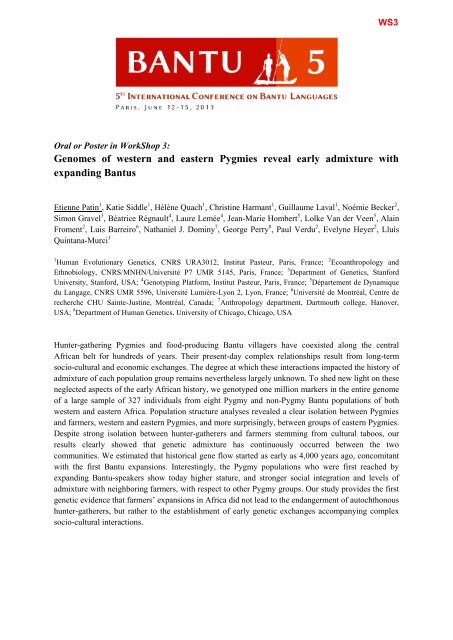here - 5th International Conference on Bantu Languages
here - 5th International Conference on Bantu Languages
here - 5th International Conference on Bantu Languages
Create successful ePaper yourself
Turn your PDF publications into a flip-book with our unique Google optimized e-Paper software.
WS3<br />
Oral or Poster in WorkShop 3:<br />
Genomes of western and eastern Pygmies reveal early admixture with<br />
expanding <strong>Bantu</strong>s<br />
Etienne Patin 1 , Katie Siddle 1 , Hélène Quach 1 , Christine Harmant 1 , Guillaume Laval 1 , Noémie Becker 2 ,<br />
Sim<strong>on</strong> Gravel 3 , Béatrice Régnault 4 , Laure Lemée 4 , Jean-Marie Hombert 5 , Lolke Van der Veen 5 , Alain<br />
Froment 2 , Luis Barreiro 6 , Nathaniel J. Dominy 7 , George Perry 8 , Paul Verdu 2 , Evelyne Heyer 2 , Lluís<br />
Quintana-Murci 1<br />
1 Human Evoluti<strong>on</strong>ary Genetics, CNRS URA3012, Institut Pasteur, Paris, France; 2 Ecoanthropology and<br />
Ethnobiology, CNRS/MNHN/Université P7 UMR 5145, Paris, France; 3 Department of Genetics, Stanford<br />
University, Stanford, USA; 4 Genotyping Platform, Institut Pasteur, Paris, France; 5 Département de Dynamique<br />
du Langage, CNRS UMR 5596, Université Lumière-Ly<strong>on</strong> 2, Ly<strong>on</strong>, France; 6 Université de M<strong>on</strong>tréal, Centre de<br />
recherche CHU Sainte-Justine, M<strong>on</strong>tréal, Canada; 7 Anthropology department, Dartmouth college, Hanover,<br />
USA; 8 Department of Human Genetics, University of Chicago, Chicago, USA<br />
Hunter-gathering Pygmies and food-producing <strong>Bantu</strong> villagers have coexisted al<strong>on</strong>g the central<br />
African belt for hundreds of years. Their present-day complex relati<strong>on</strong>ships result from l<strong>on</strong>g-term<br />
socio-cultural and ec<strong>on</strong>omic exchanges. The degree at which these interacti<strong>on</strong>s impacted the history of<br />
admixture of each populati<strong>on</strong> group remains nevertheless largely unknown. To shed new light <strong>on</strong> these<br />
neglected aspects of the early African history, we genotyped <strong>on</strong>e milli<strong>on</strong> markers in the entire genome<br />
of a large sample of 327 individuals from eight Pygmy and n<strong>on</strong>-Pygmy <strong>Bantu</strong> populati<strong>on</strong>s of both<br />
western and eastern Africa. Populati<strong>on</strong> structure analyses revealed a clear isolati<strong>on</strong> between Pygmies<br />
and farmers, western and eastern Pygmies, and more surprisingly, between groups of eastern Pygmies.<br />
Despite str<strong>on</strong>g isolati<strong>on</strong> between hunter-gat<str<strong>on</strong>g>here</str<strong>on</strong>g>rs and farmers stemming from cultural taboos, our<br />
results clearly showed that genetic admixture has c<strong>on</strong>tinuously occurred between the two<br />
communities. We estimated that historical gene flow started as early as 4,000 years ago, c<strong>on</strong>comitant<br />
with the first <strong>Bantu</strong> expansi<strong>on</strong>s. Interestingly, the Pygmy populati<strong>on</strong>s who were first reached by<br />
expanding <strong>Bantu</strong>-speakers show today higher stature, and str<strong>on</strong>ger social integrati<strong>on</strong> and levels of<br />
admixture with neighboring farmers, with respect to other Pygmy groups. Our study provides the first<br />
genetic evidence that farmers’ expansi<strong>on</strong>s in Africa did not lead to the endangerment of autochth<strong>on</strong>ous<br />
hunter-gat<str<strong>on</strong>g>here</str<strong>on</strong>g>rs, but rather to the establishment of early genetic exchanges accompanying complex<br />
socio-cultural interacti<strong>on</strong>s.


